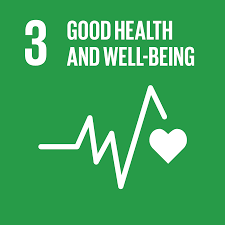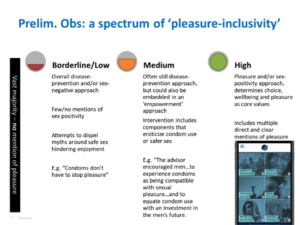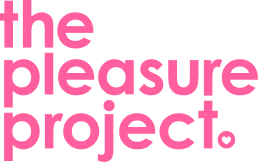There is a growing body of evidence about the impact of pleasure-positive approaches on sexual health.
Use this knowledge to spread sex-positivity.
Though there is increasing evidence on the link between pleasure and health with improved sexual and overall well-being, many practitioners, educators, and policymakers are hesitant to include pleasure-centred approaches in their programmes and work. The discussion of sexual pleasure has long been stigmatised and taboo in the public health world. Learning about sexual pleasure has been traditionally overlooked or stigmatised.
For example, we reviewed international conferences on SRH and HIV over the past two decades and observed that the topic of sexual pleasure was included overall in only 0.5 % or less than 1% of the abstracts and sessions. We have included this analysis in this article.
 The Sustainable Development Goals (SDGs) also have no mention of sexual pleasure. However, SDG 3 is inclusive of “well-being” and includes a specific target focused on ensuring universal access to sexual and reproductive health care services. Also, the World Health Organisation working definition of sexual health does include the ‘possibility of having pleasurable and safe sexual experiences
The Sustainable Development Goals (SDGs) also have no mention of sexual pleasure. However, SDG 3 is inclusive of “well-being” and includes a specific target focused on ensuring universal access to sexual and reproductive health care services. Also, the World Health Organisation working definition of sexual health does include the ‘possibility of having pleasurable and safe sexual experiences
Focusing only on the negative consequences of sex has affected research funding. Most (international) organizations/governments prefer to fund research that looks at the unintended /unwanted consequences of sex and shy away from learning more about sexual well-being and pleasure.
However, sexual well-being and sexual pleasure are emerging as new narratives and aspirational goals in sexual and reproductive health. Some research is starting to test the potential of sexually explicit media to address safer sex and sexual rights, given the ever-increasing free access to explicit content online. In addition, there has been some very useful recent work to re-frame sexual health towards well-being and pleasure. The Guttmacher – Lancet Commission pointed this out in 2018 by saying “a positive approach to sexuality and reproduction should recognise the part played by pleasurable sexual relationships, trust, and communication in the promotion of self-esteem and overall well-being.”
Some authors have also created a new framework for sexual well-being as one component of our sexuality and sexual rights alongside sexual justice, sexual pleasure and sexual health. This can help shape our thinking for future learning. We believe that it is important to build more evidence, as well as share the evidence we have that pleasure inclusive sexual health leads to more sexual health and sexual empowerment.
Evidence shows that a failure to address sexual well-being and pleasure detract from an exploration of sexuality or safer sex. It limits conversations about the real concerns related to contraceptives and other sexual health programmes. This often denies females and people with marginalised identities sexual pleasure or emphasises that sex isn’t for fun or for general well-being and happiness.
There is increasing evidence that shows linkages between improved sexual health and sexual pleasure, safer sex and contraceptive behaviour. The Pleasure Project has conducted a systematic review and meta-analysis with The World Health Organisation to show that pleasure inclusive sexual health interventions can improve sexual health outcomes! This adds to earlier work by Scott-Sheldon that showed that eroticising condom use actually improved condom use. We have summarised much of the earlier evidence in our document here.
The World Association of Sexual Health have also comprehensively reviewed the evidence that supports their Sexual Pleasure Declaration in a technical document. This highlights that pleasure can be an indicator of empowerment, can protect people’s sexual rights, and can be effective with people who have suffered sexual trauma.
Including pleasure in our interventions happens on a spectrum. From a small component in an otherwise sex-negative intervention (such as eroticising condom use in a disease-focused research study) to interventions that embody all elements of The Pleasure Principles and have the aim of being pleasure-based as a goal for those involved.
(See some examples of this Pleasure Spectrum here.)
 We can Embrace Learning as a Pleasure Principle by aiming for a world where pleasure, well-being and happiness are our goals rather than purely disease prevention. We need to encourage more research and learning on sexual pleasure in our work. We sometimes call this an asset-based approach, where we aim to improve people’s lives by focusing on the benefits of a behaviour or act and the capacities and skills people have.
We can Embrace Learning as a Pleasure Principle by aiming for a world where pleasure, well-being and happiness are our goals rather than purely disease prevention. We need to encourage more research and learning on sexual pleasure in our work. We sometimes call this an asset-based approach, where we aim to improve people’s lives by focusing on the benefits of a behaviour or act and the capacities and skills people have.
How can we Embrace Learning about Pleasure based sexual health in our work?
- We can start by evaluating and assessing the emotional and mental aspects of sexual pleasure in any intervention.
- We need to develop indicators on the impact of pleasure-positive approaches and share our learning with peers and other stakeholders.
- We should work towards using indicators on how people can be supported at different ages and in different contexts to resolve the fears, doubts, contradictions, misconceptions, and behaviours that cause anguish about sexual pleasure. This will help them to develop their ability to enjoy sex physically, emotionally and mentally.
- We must aspire to develop standardized indicators to measure progress in our sexual pleasure related work. The research “I tell them that sex is sweet at the right time’, a qualitative review of ‘pleasure gaps and opportunities’ in sexuality education programmes in Ghana and Kenya, defines learning objectives for pleasure based comprehensive sexuality education.
- We can undertake more research on how trauma survivors can cope with their feelings and emotions and work towards positive sexual relationships in the future. Research shows the potential of having unsafe sexual behaviour can be due to stress or trauma as a result of sexual and gender based violence. Other research shows that gender inequity, gender-based violence, and unsafe sexual behaviour are linked to each other.
- We can learn more about the meaning of sexual pleasure in different social contexts and systems and during the life cycle of diverse populations. Here is a 2021 article looking at sexual health and well being through the life cycle.
- Amplify Change grantee’s have started to measure pleasure in their work and how it affects their impact on sexual health. These resources show a range of research methods you can use if you also want to try this.
- The GAB pleasure meter (https://pleasure-checklist.share-net.nl/) is a useful way to work with clients/learners in exploring what aspects of sexual pleasure are going well and which aspects need further learning for improvement. The elements of the meter, including physical and emotional satisfaction, self-esteem, feelings of safety, and communication skills can also be used as indicators for further research and learning.
- To expand our learning about sexual pleasure, we may need to find new ways outside the existing evidence box. This means we should move away from only using traditional randomized control research and embrace research methods that are often documented as “grey” literature or evidence. What is particularly needed is to learn and find evidence about how to put the issue of sexual pleasure into practice for practitioners, educators and policymakers. There are various scales to measure clients’ attitudes, emotions and behaviour. The “Comfort with Sexual Behaviors Scale” (CBS) and The Sexual Pleasure Meter by GAB are among the useful methods to assess and discuss sexual pleasure and wellbeing with clients.
Tips and Actions
- Adopt a strengths-based approach (SBA) to focus our learning on the strengths and assets of individuals and contexts. This is in contrast to the traditional approach which centres on weaknesses and challenges. Applying this approach to address gaps in our learning will make it more empowering and productive for both the learners and the educators/teachers. In other words, let us first look at what assets we can already use to integrate sexual pleasure in our professional skills and resources. Have a critical lens when looking at existing research /evidence about sexuality and sexual pleasure as these often use only a medical or a public health approach.
- Create goals, objectives, and key performance indicators (KPIs) that focus on pleasure and well-being to measure and track your journey towards them.
- Expand areas of learning to include the impact of lived experiences , social contexts, systems, and the lifecycle on the meaning and experiences of sexual pleasure.
- Expand and explore new ways of learning and collecting evidence indicators that work for you and your community and for the pleasure-based sexual health world. Keep building the Pleasure Wave.
Further resources you might find useful
Anderson, R.M. (2013). Positive sexuality and its impact on overall wellbeing. Bundesgesundheitsblatt – Gesundheitsforschung – Gesundheitsschutz 2. https://pubmed.ncbi.nlm.nih.gov/23361205/
Bornefeld-Ettmann P, et al (2018), Sexual Functioning After Childhood Abuse: The Influence of Post-Traumatic Stress Disorder and Trauma Exposure”, J Sex Med 2018;15:529-538, https://doi.org/10.1016/j.jsxm.2018.02.016
Castellanos-Usigli, A. & Braeken-van Schaik, D. (2019) The Pleasuremeter: exploring the links between sexual health, sexual rights and sexual pleasure in sexual history-taking, SRHR counselling and education, Sexual and Reproductive Health Matters, 27:1, 313-315, DOI: 10.1080/26410397.2019.1690334
Cense, M Navigating a bumpy road Young people’s negotiation of sexual agency in a normative landscape, Amsterdam 2019
Fava, N., &. Fortenberry, J.D., Trauma-Informed Sex Positive Approaches to Sexual Pleasure, International Journal of Sexual Health, 2021 https://doi.org/10.1080/19317611.2021.1961965
Ford J.V., Corona Vargas E., Finotelli Jr I., Fortenberry JD, Kismödi E., Philpott A., Rubio-Aurioles E. and Coleman E. (2019). Why pleasure matters: its global relevance for sexual health, sexual rights and wellbeing. International Journal of Sexual Health, 31:3, 217-230, DOI: 10.1080/19317611.2019.1654587
Ford, J., Corona, E., Cruz,M., Fortenberry, D. Kismodi, E., Philpott, A., Rubio-Aurioles, E. and Coleman, E. (2021) ‘The World Association for Sexual Health’s Declaration on Sexual Pleasure: Addressing Sexual Pleasure to Achieve Sexual Health and Wellbeing’ International Journal of Sexual Health
Ford J.V., El Kak, F., Herbenick, D., Purdy, C., Tellone,S., Wasserman, M. & Coleman, E. (2021) Sexual Pleasure and Healthcare Settings: Focusing on Pleasure to Improve Healthcare Delivery and Utilization, International Journal of Sexual Health, DOI: 10.1080/19317611.2021.1955802
Global Advisory Board for sexual health and wellbeing, SEXUAL PLEASURE: The forgotten link in sexual and reproductive health and rights (GAB, 2018) https://www.gab-shw.org/media/1024/gab_sexualpleasuretrainingtoolkit_final_webversion_withhyperlinks_updateapril2019.pdf
Haberland, N. The Case for Addressing Gender and Power in Sexuality And HIV Education: A Comprehensive Review of Evaluation Studies https://bit.ly/36heXcPhttps://bit.ly/36heXcP
Jenny A. Higgins & Nicole K. Smith (2016) The Sexual Acceptability of Contraception: Reviewing the Literature and Building a New Concept, The Journal of Sex Research, 53:4-5, 417-456, DOI: 10.1080/00224499.2015.1134425
Kågesten, A., & van Reeuwijk, M. (2021, February 15). Adolescent Sexual Wellbeing: A Conceptual Framework. https://doi.org/10.31235/osf.io/9as6e
Logie CL., (2021) Sexual rights and sexual pleasure: Sustainable Development Goals and the omitted dimensions of the leave no one behind sexual health agenda, Global Public Health, DOI: 10.1080/17441692.2021.1953559
Mercer, M.E,. (2020) Development of the Comfort with Sexual Behaviors Scale. Journal of sexual counselling and sexual wellness 2020 https://digitalcommons.unf.edu/jcssw/vol2/iss1/7/
Mitchell K.R., Lewis, R., O’Sullivan, L. S. Fortenberry, D. (2021), What is sexual wellbeing and why does it matter for public health? The Lancet Vol 6 August 2021. https://doi.org/10.1016/S2468-2667(21)00099-2
Philpott, A., Larsson, G., Singh, A., Zaneva M. & Gonsalves L. (2021) How to Navigate a Blindspot: Pleasure in Sexual and Reproductive Health and Rights Programming and Research, International Journal of Sexual Health, DOI: 10.1080/19317611.2021.1965690
Philpott, A., Knerr, W., & Boydell, V. (2006) Pleasure and Prevention: When Good Sex Is Safer Sex, Reproductive Health Matters,14:28,23-31,DOI:10.1016/S0968-8080(06)28254-5
Singh, A., Boh, R., Philpott, A., (2020) ‘I tell them that sex is sweet at the right time’ – A qualitative review of ‘pleasure gaps and opportunities’ in sexuality education programmes in Ghana and Kenya. Global Public Health, https://www.tandfonline.com/doi/full/10.1080/17441692.2020.1809691
Sladden, T., Philpott, A., Braeken, D., Castellanos-Usigli, A., Yadav, V., Christie, E., Gonsalves, L. & Mofokeng, T. (2021) Sexual Health and Wellbeing through the Life Course: Ensuring Sexual Health, Rights and Pleasure for All, International Journal of Sexual Health, DOI: 10.1080/19317611.2021.1991071
Here are some research studies that have measured the impact of pleasure in their interventions
Andrade HH, Mello MB, Sousa MH, Makuch MY, Bertoni N, Faúndes A. (2009) Changes in sexual behavior following a sex education program in Brazilian public schools. Cad Saude Publica. May;25(5):1168-76. doi: 10.1590/s0102-311×2009000500023. PMID: 19488501.
Bauermeister JA, Tingler RC, Demers M, Connochie D, Gillard G, Shaver J, Chavanduka T, Harper GW. (2019) Acceptability and Preliminary Efficacy of an Online HIV Prevention Intervention for Single Young Men Who Have Sex with Men Seeking Partners Online: The myDEx Project. AIDS Behav. Nov;23(11):3064-3077. doi: 10.1007/s10461-019-02426-7 .
Diallo DD, Moore TW, Ngalame PM, White LD, Herbst JH, Painter TM. (2010) Efficacy of a single-session HIV prevention intervention for black women: a group randomized controlled trial. AIDS Behav. Jun;14(3):518-29. doi: 10.1007/s10461-010-9672-5. PMID: 20135214.
Scott-Sheldon, L., & Johnson, B. (2006). Eroticizing creates safer sex: A research synthesis. The Journal of Primary Prevention, 27(6), 619–640. https://doi.org/10.1007/ s10935-006-0059-3
Zaneva M, Philpott A, Singh A, Larsson G, Gonsalves L (2022) What is the added value of incorporating pleasure in sexual health interventions? A systematic review and meta-analysis. PLoS ONE 17(2): e0261034. https://doi.org/10.1371/journal.pone.0261034
Checklist/assessment guides to evaluate monitor integration of pleasure in programmes (please send us more as you develop them)
https://pleasure-checklist.share-net.nl
https://www.gab-shw.org/resources/sexual-pleasure-an-assessment-tool/

